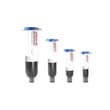LOCTITE ABLESTIK 84-3
- Solvent-free
- Aerospace applications
- Bonds to multiple substrates
Product Description
LOCTITE ABLESTIK 84-3 non conductive adhesive is designed for medium size die attach and assembly applications. This adhesive is ideal for application by automatic dispensing, screen printing or hand. It has fairly high viscosity and can be applied by dispense or print while also resisting air expansion. Additionally, it is epoxy-based, so should bond well to almost any surface. It's poison ration is estimated at ±0.3 which is typical for epoxy adhesives.
LOCTITE ABLESTIK 84-3 is based on the tried and true 84-1LMI chemistry, has a well defined operating temperature range and is well accepted in military/defense applications for several years. It meets the requirements of MIL-STD-883, Method 5011 and passes NASA outgassing standards if cured properly but is epoxy based and is unlikely to survive the AuSn reflow process.
The weight loss of 84-3 at 300 °C is only 0.17%, but the properties, performance, and reliability after the AuSn reflow profile would have to be tested.
Cure Schedule
- 1 hour @ 150°C
- 2 hours @ 125°C
Technical Specifications
| General Properties | |
| Density (g) | 1.7 g/cm3 |
| Work life @25°C Work life @25°C Work life is the amount of time we have to work with a material until it is no longer able to be easily worked and applied on a substrate. It is based on the change in viscosity and it can rely on the application requirements. | 336 hours |
| Thermal Properties | |
| Glass Transition Temperature (Tg) Glass Transition Temperature (Tg) The glass transition temperature for organic adhesives is a temperature region where the polymers change from glassy and brittle to soft and rubbery. Increasing the temperature further continues the softening process as the viscosity drops too. Temperatures between the glass transition temperature and below the decomposition point of the adhesive are the best region for bonding. The glass-transition temperature Tg of a material characterizes the range of temperatures over which this glass transition occurs. | 85 °C |
| Thermal Conductivity Thermal Conductivity Thermal conductivity describes the ability of a material to conduct heat. It is required by power packages in order to dissipate heat and maintain stable electrical performance. Thermal conductivity units are [W/(m K)] in the SI system and [Btu/(hr ft °F)] in the Imperial system. | 0.8 W/m.K |
| Weight Loss @ 300°C | 0.17 % |
| Physical Properties | |
| Thixotropic index Thixotropic index Thixotropic Index is a ratio of a material s viscosity at two different speeds in Ambient temperature, generally different by a factor of ten. A thixotropic material s viscosity will decrease as agitation or pressure is increased. It indicates the capability of a material to hold its shape. Mayonnaise is a great example of this. It holds its shape very well, but when a shear stress is applied, the material easily spreads. It helps in choosing a material in accordance to the application, dispense method and viscosity of a material. | 14 |
| Viscosity Viscosity Viscosity is a measurement of a fluid’s resistance to flow. Viscosity is commonly measured in centiPoise (cP). One cP is defined as the viscosity of water and all other viscosities are derived from this base. MPa is another common unit with a 1:1 conversion to cP. A product like honey would have a much higher viscosity -around 10,000 cPs- compared to water. As a result, honey would flow much slower out of a tipped glass than water would. The viscosity of a material can be decreased with an increase in temperature in order to better suit an application | 50,000 mPa.s |



